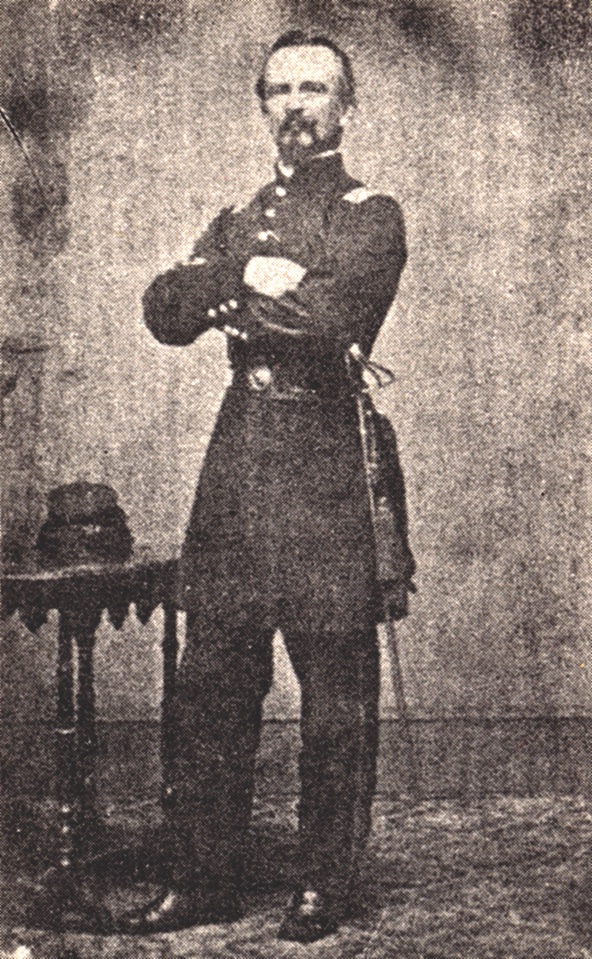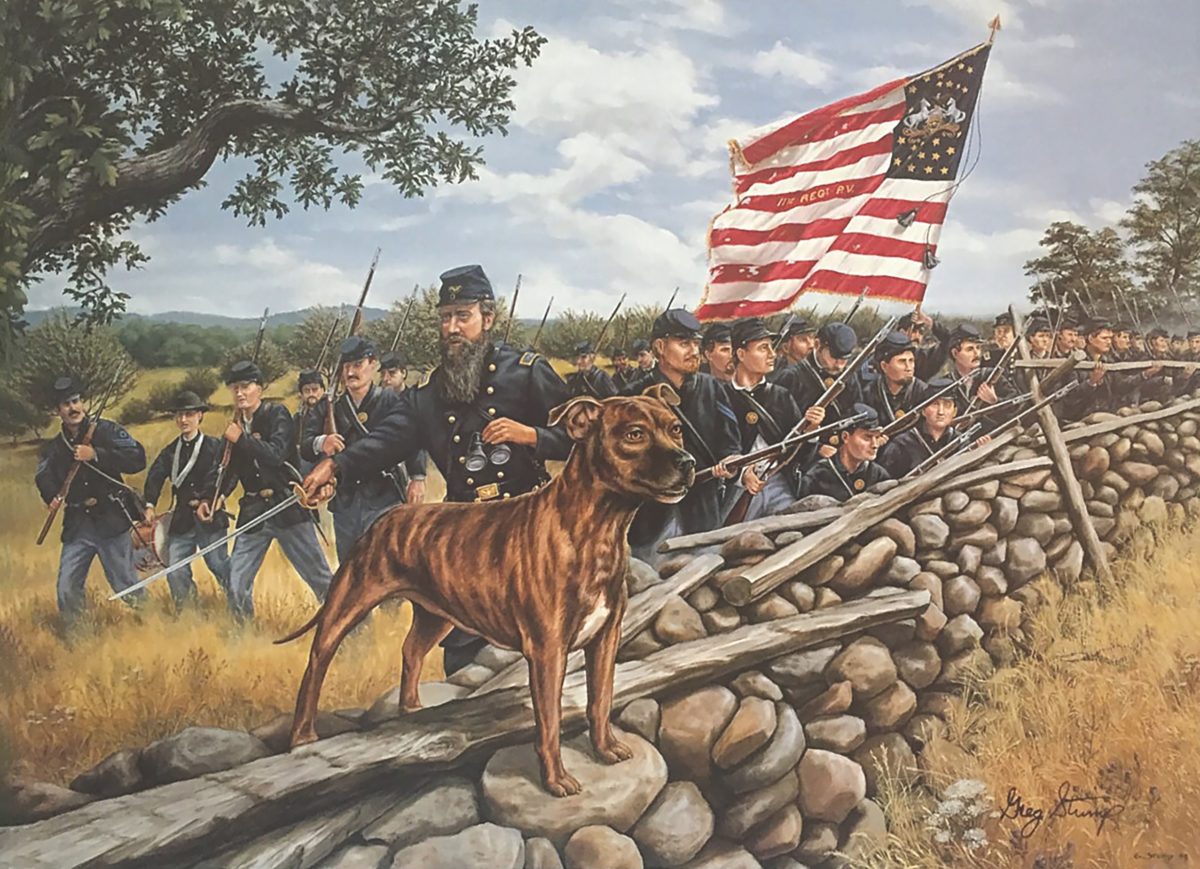Grayfriars Bobby, a Scottish Skye Terrier known for once guarding his owner’s grave in Edinburgh for 14 years, is an apt reminder of the deep and long connection and affection between dogs and humans throughout history. For as long as there have been soldiers in the earliest formed armies, they have had dogs as pets and mascots. In a personal, modern example, my son’s Army scout platoon in Afghanistan adopted a female Afghan Kuchi puppy that it named “Scout.” Scout was so special and important that Jason went through considerable effort to have her sent home when he left, and she lives happily with him in the United States today. At Antietam in September 1862, countless units in both armies were accompanied by faithful canine companions, and many of them went into battle alongside their human comrades.
The most famous of these army dogs was a Staffordshire terrier named Sallie, adopted as a puppy by the 11th Pennsylvania Infantry in the spring of 1861. Many today know Sallie from her sculpture on the front of the regiment’s monument at Gettysburg. Sallie became a favorite with the regiment and a celebrity in the brigade. George Kimball, a soldier in the 12th Massachusetts, wrote how much he enjoyed visiting the 11th Pennsylvania’s camp just to watch Sallie when the regiment performed dress parade. He wrote of observing the “drum corps slowly marching down the front, the colonel [Richard Coulter] with folded arms calmly looking into the faces of the men and Sallie lying at the feet of the color bearer, as if she loved to be in the shadow of the flag.”
It was said that if the 11th experienced a particularly severe march, the unit could be counted upon to be represented at its conclusion “by a colonel, a flag and a dog,” for Sallie never straggled. She also never shirked a battle and went in with the 11th when it marched through David Miller’s Cornfield at Antietam the morning of
September 17, 1862.
The dog that could salute
Not far from Sallie, a black-and-white Newfoundland breed trotted along the Hagerstown Pike with its owner, Captain Werner von Bachelle of the 6th Wisconsin. The German-born von Bachelle was somewhat a soldier of fortune. He had trained at a Swiss military academy and saw service in the French army and with Garibaldi in the war for Italian unification.
A fellow officer described the German as a “tall and stalwart soldier” and rigid disciplinarian. Because his English was limited and his demeanor reserved and formal, he had few friends among the regiment’s officers, but the soldiers of his Company F developed a fondness for their captain. Earlier in the summer, when the 6th Wisconsin was stationed near Fredericksburg, Va., the black-and-white canine wandered into Company F’s camp. The men knew how much von Bachelle loved animals, so they gave him the dog as a pet. The two were soon inseparable, becoming the “most devoted friends on earth.”
Von Bachelle trained the creature to give military salutes “and other remarkable things”—where he went, he was always accompanied by his dog. That morning of September 17, it was with him as they advanced astride the Hagerstown Pike at the spearpoint of the Union 1st Corps’ attack. Company F stretched directly across the turnpike in the regimental line. They passed the David Miller Farm and the left of the regiment entered Miller’s 30-acre cornfield. The ground sloped up to a slight east-west ridge just south of the corn. As the regiment neared this point, a Confederate limber and gun suddenly burst into view and disappeared behind the ridge driving south along the pike. Von Bachelle’s company was ordered to hustle to the ridge and shoot up the enemy gun team. When they reached the crest of the ridge, they were confronted by two small brigades of Confederate infantry lying at their right front. The Rebels quickly rose and blasted Company F. Hit at least 12 times, von Bachelle was killed instantly.

a mascot for every company
A soldier in the 1st Delaware, writing under the pseudonym “Billy,” noted that every company in the regiment had a dog as a mascot, but the boldest of the lot was “Scott,” who belonged to Company G and followed it at Antietam during the regiment’s assault on the Sunken Lane. According to Billy, when a solid shot struck near Scott, the dog commenced digging furiously at the spot. At one point, Scott mounted a charge on the enemy, running up barking to what was probably the rail fence at the southern edge of Samuel Mumma’s cornfield, where he “put his paws on it, deliberately gazed at Secesh, then beat a masterly retreat back to the company.” He then proceeded to run back and forth along the regiment’s line, and although “the bullets rained thick and fast” he escaped unscathed. Scott was exceedingly lucky, as the 1st Delaware suffered 230 casualties that day—the heaviest loss of any regiment in Maj. Gen. William French’s 3rd Division.
The 6th New Hampshire had what was probably a Chesapeake breed, an ocher-colored dog they had adopted as a puppy in Elizabeth City, N.C. It became known as the “Sixth Regiment Dog” and accompanied the regiment in camp, on the march, and in battle. On the morning of September 17, it joined the regiment when it and the 2nd Maryland made the second attempt to capture the Rohrback Bridge. “Dogs generally fear firearms when discharged in volleys,” recalled the regimental historian, but “this one went fearlessly into battle.” Like Scott and Sallie, the Sixth Regiment Dog survived the combat its regiment engaged in that day.
But just like the men they went into battle with, there was not a happy ending for some dogs. Captain von Bachelle’s Newfoundland loyally remained by his side when he was killed and refused to leave his body even though urged to do so by some of the captain’s men. This was one of the most hotly contested spots on the entire Antietam battlefield and units fought over the area throughout the morning. The next morning a burial detail from the 6th Wisconsin found von Bachelle’s beloved pet lying across the captain’s body. They buried them together. And Sallie may have survived Antietam but she did not survive the war. She was wounded at Spotsylvania and killed at Hatcher’s Run in February 1865. Like Grayfriars Bobby, Sallie and von Bachelle’s Newfoundland were loyal to their human companions unto death.
historynet magazines
Our 9 best-selling history titles feature in-depth storytelling and iconic imagery to engage and inform on the people, the wars, and the events that shaped America and the world.







